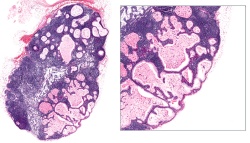Uterine Bleeding
Uterine bleeding, or dysfunctional uterine bleeding, refers to benign abnormal bleeding. It is a common problem in women 30 - 50 years old[1] and is associated with conditions such as fibroids or endometrial polyps.
|
Uterine Bleeding | |
| See Also | Women's Health, Uterine Fibroids, Iron Deficiency |
|---|---|
| Books | Books on Women's Health |
| Articles | Articles on Women's Health |
Contents
Related Symptoms and Conditions
The following conditions commonly have abnormal uterine bleeding as a symptom:[2]
- Uterine Fibroids
- Endometrial polyps
- Endometrial cancer
- Endometrial cancer is the most common malignancy of the female genital tract and its main symptom is abnormal uterine bleeding. Women with abnormal uterine bleeding who are 35 years and older should have an endometrial evaluation.[3]
- Dysfunctional uterine bleeding is the most common commonest cause of iron deficiency anemia in the developed world.[1]
Characteristics
Uterine bleeding typically occurs due to an anovulatory cycle (when the ovaries do not release an egg). When an egg is not released during ovulation, the endometrial tissue is stimulated by excessive and prolonged exposure to estrogen. Because ovulation must occur for progesterone to be produced, progesterone is often low.[4] Uterine bleeding can also occur with ovulatory cycles.[5]
Common Symptoms
- Dysfunctional uterine bleeding can manifest in several ways:
- Bleeding or spotting between menstrual periods
- Periods that are less than 28 days or longer than 35 days apart
- Cycles that vary in length from month to month
- Heavy bleeding
- Bleeding that lasts longer than 7 days
Diagnostic Testing
A variety of tests may be required to determine the source of uterine bleeding:[2] Dysfunctional uterine bleeding is a diagnosis of exclusion, uterine and systemic causes must be excluded using the following investigations:[6]
- Physical exam including a pap smear and culture
- Blood tests including Complete Blood Count (CBC), ferritin, blood clotting profile, hormone testing (FSH, LH, Androgens, Prolactin, Progesterone, TSH), pregnancy test
- Imaging tests including a pelvic ultrasound or endometrial biopsy
Common Questions
- When was your last menstrual period?
- How long is your cycle?
- How many days do you bleed?
- Is the flow heavy or light? Are there clots?
- Do you have breakthrough bleeding or spotting?
- Do you have any premenstrual symptoms?
- Are you trying to get pregnant?
- Have you ever been pregnant?
- Do you bruise or bleed easily?
- Are you sexually active?
- What forms of contraception do you use?
- Is there a history of sexually transmitted diseases?
Naturopathic Treatment
The goal of naturopathic treatment is to support and work in tandem with the healing power of the body and to address the causal factors of disease with individual treatment strategies. Though some cases of uterine bleeding may require urgent attention, most cases are due to benign conditions that are easily addressed.[2] The naturopathic treatment strategy for uterine bleeding involves addressing the underlying condition, such as uterine fibroids.
It is always advisable to work with a naturopathic doctor before engaging in any treatment plan.
References
Reviewed by Iva Lloyd, BScH, RPE, ND [1]
- ↑ 1.0 1.1 Farrell E (2004 Nov) Dysfunctional uterine bleeding Aust Fam Physician;Vol33(11):906-8 PMID: 15584330.
- ↑ 2.0 2.1 2.2 Hudson T (2007) Women's Encyclopedia of Natural Medicine: Alternative Therapies and Integrative Medicine for Total Health. McGraw-Hill.
- ↑ Albers JR, Hull SK, Wesley RM (2004 Apr 15) Abnormal uterine bleeding Am Fam Physician;Vol69(8):1915-26 PMID: 15117012.
- ↑ Kumar R, Abbas A, DeLancey A, Malone E (2010) Robbins and Cotran Pathologic Basis of Disease. Eighth Edition. Saunders Elsevier.
- ↑ Chen BH, Giudice LC (1998 Nov) Dysfunctional uterine bleeding West J Med;Vol169(5):280-4 PMID: 9830356.
- ↑ Pitkin J (2007 May) Dysfunctional uterine bleeding BMJ;Vol334(7603):1110-1 PMID: 17525454.

